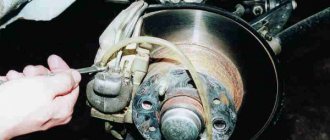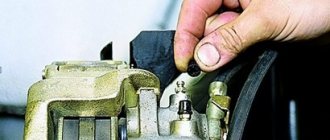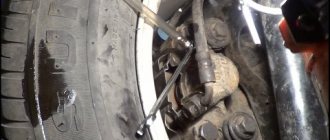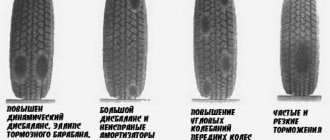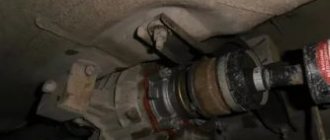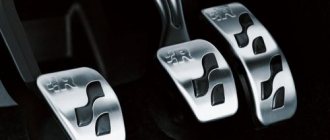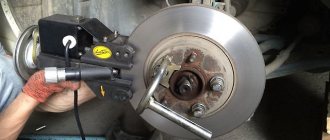Why does the brake pedal hit when braking?
Why does the brake pedal squeal when you press the brake? Most often, when various malfunctions are detected, motorists turn to a specialized service.
Do-it-yourself windshield polishing? See here for detailed instructions.
Do-it-yourself ignition switch illumination, more details in our article.
Do you need to replace your front suspension springs? You will find details in this article.
Yes, this is a common cause of “impacts” on the steering wheel or brake pedal, but there are still other malfunctions that give such a result. Let's consider what main malfunctions can cause such behavior of the car when the speed decreases.
- The first reason, which we have already described above, is deformation of the brake disc. Most often this happens due to severe overheating. The average operating temperature of a modern brake disc is 200-300 degrees. Overheated soft metal is prone to deformation, which causes irregularities to appear on the surface of the disk, which cause shocks. This problem can be solved by replacing the disks. If your driving style is quite aggressive, then you should consider purchasing brake discs that are more temperature-resistant. The ventilation of the disks, as well as their area, is responsible for heat resistance; the larger it is, the better the heat transfer.
- Wear of brake discs. With severe and uneven wear, scuffing may appear on the braking surface of the “pancake”, which will cause runout. Just a replacement solution. If the discs on one axle have uneven wear, it means that the braking of the right and left wheels occurs unevenly, which can also complicate driving and become a threat to life.
- Overheating of Ferodo coating on the pads. When the brake surface of the pads overheats, the friction linings simply begin to crumble, which is why they cannot properly and evenly press the brake disc and stop the wheel.
- Uneven or severe pad wear. Just like the surface of the disc, the braking surface of ferodo pads wears out over time. Wear may occur unevenly, which will affect the wear of the disc and the process of stopping the rotation of the wheel. Everything can be solved with a simple replacement. If the brake discs still have a sufficient layer of working surface and there are no defects, then you can only get by by replacing the pads as a pair on the axle. When installing new pads, be sure to clean the bracket, otherwise this may lead to the pad becoming sour over time. The pad must have free play in the bracket so that the caliper correctly presses its entire surface against the brake disc.
- Inoperative brake caliper cylinders. Another common problem is stuck pistons. This often happens due to torn boots of the brake pistons; because of this, dirt and moisture get into the brake cylinder, which “kills” the lubrication of the mechanism, which over time leads to souring and inoperability of the entire device. A caliper repair kit will help solve this problem. The kit will include a new boot, brake piston and lubricant. Everything is simple, you just need to “squeeze” the old piston out of the cylinder by pressing the brake pedal, then we clean everything, lubricate the cylinder walls, the piston and press it back, and install a new boot.
- Worn rear brake pads. Often noticeable only during heavy braking. Usually, in moderate driving mode, only the front mechanisms are involved in the braking process, the rear mechanisms are connected either later or during sharp braking. So if the beating does not occur with pressing the pedal, but later or towards the end, then this is most likely due to worn rear brake pads.
- Rear brake drums are worn or bent. When braking, the drum presses the pad unevenly or inconsistently, so there is no full contact between the pad and the braking surface, braking efficiency decreases and vibration is transmitted to the pedal or body. The reason for wear of these parts is most often their age, and the solution to this issue is simple - replacing worn out consumables with new ones.
- Severe wear on wheel bearings. Due to play and wear of the bearing working surface, vibration and hum are transmitted to the wheel. When braking, the front suspension of the car is loaded, which creates vibration from the bearing. It is possible to check bearing wear on a lift by checking the wheel for vertical play; if there is any, then the bearing has already “outlived” its usefulness and needs to be replaced.
Causes of pedal beat.
There are actually not many components in a car's braking system that can fail and lead to this problem. If the brake pedal starts to beat, then first of all you should check the main components of the system:
- Brake pads. Perhaps they have exhausted their resource and that is why the pedal beat appears. In this case, it is necessary to check the wear level of the front and rear brake pads. Their thickness should not be below the permissible values. Typically, a visual inspection is performed to determine this. On disc and drum brakes, the pads have special notches that disappear when the pads are heavily abraded. In this case, it is better to replace them in pairs, on each axis.
- Brake drum. The reason may also be hidden in the drum itself. When braking, the pads come into contact with it. Therefore, if it is deformed or has mechanical damage, strong vibration may occur, which is transmitted to the brake pedal and the car body. To avoid such a problem in the future, it is worth changing both brake drums, since the second one may also fail soon.
- Brake discs. In addition to the impact of large frictional forces, brake discs are greatly affected by temperature loads, since due to the design features, the pads act on the discs simultaneously from both sides. This increases the beneficial effect, but requires more time to cool the disk.
- Brake cylinders. If they are slightly deformed, then the system may depressurize, as well as the pads will not fit tightly to the drum. If, upon visual inspection, distortion or traces of grease or rust are noticeable, then it is necessary to replace or lubricate the brake cylinders.
It is important to remember that replacing brake discs, pads or drums is done in pairs, on each axis. After replacement, you need to run in the parts a little. This can be done by braking several times while driving in first gear. The run-in should be done in a place where there are no people or other cars nearby, so that if any problems arise, it will not cause an accident.
Summarizing
The vibration of the brake pedal when braking is one of the symptoms of a malfunctioning brake system. The consequences can be very different from simple wear of parts to the creation of emergency situations due to brake failure.
For full operation of the brake system, full contact between the surface of the friction lining of the pad and the brake disc is necessary. If replacing worn parts helped only temporarily, maybe you should think about changing your driving style, because it is your driving style that affects the service life of the parts.
You should also not allow the temperature of heated elements (discs and calipers) to change; try to avoid puddles after braking, and also allow the brakes to cool before washing the car. To avoid breakdowns, you should visit service stations more often to check the performance and preventive maintenance of brake mechanisms, repair them in a timely manner, and also periodically inspect your brakes yourself.
You can test and find any faults in the brake system in your car on an empty section of the road, away from houses and pedestrians in order to avoid accidents.
First of all, you should carefully monitor the car’s braking process, listen to see if there are any extraneous noises or squeaks, whether the braking is uniform, or whether the direction of movement changes during sudden braking.
Vibration of various elements of the car inevitably occurs during operation, when the moving parts of the chassis and transmission gradually wear out. But among such malfunctions, there is one dangerous malfunction - the steering wheel wobbles when braking. The more the steering wheel jerks after pressing the brake pedal sharply, the higher the likelihood of losing control and flying off the road at a decent speed. To avoid the described emergency situation, it is worth studying the nature of the problem and how to solve it.
What to do if the brake system is working properly.
If a visual inspection does not reveal any faults, or after replacing any elements the problem still persists, you need to check the following elements:
- wheel balancing.
- suspension arms, their fastenings
- brake system fastening elements
Problems with the brake system should not be ignored. In the future, this can lead to more expensive repairs or accidents on the roads.
Where does steering wheel wobble come from?
Steering wheel beating at the moment of braking means spontaneous jerking of the steering wheel in different directions. In especially advanced cases, the vibration is so strong that the driver has to literally catch the car on the road. At speeds above 50 km/h, the phenomenon creates a real danger for vehicle passengers.
Since the steering wheel is rigidly connected to the front wheel hubs through a rack and ball ends, the source of the problem must be sought in the chassis and braking system of the car. The main causes of strong vibration lie in various defects of the brake disc:
- the working part of the product is deformed and has a wavy surface;
- due to the impact, the disk was damaged and cracked;
- The spare part was originally defective or installed incorrectly.
It is no coincidence that the front brake discs are named as the culprits. As soon as the working surface of the part changes its shape a little or gets a defect, after the pads are activated, the front wheels will begin to wobble, repeating the rotation of the uneven element. The steering wheel hits even harder when braking at high speed, as the speed of the front wheels increases.
How a wave-like deformation appears on a disk:
- As the car moves, the elements are repeatedly captured by the pads and can become very hot.
- The temperature is distributed unevenly over the surface; accordingly, the metal in different parts of the part expands more or less.
- If, at the moment of maximum heating, the wheel falls into a puddle or snow, the metal cools sharply and retains its concave shape.
- The brake pads grip the disc and force the wheel to follow the path of rotation of the deformed surface. This is why the steering wheel shakes when braking.
Other causes of vibration
Steering wheel vibrations that are not associated with the car jerking in different directions appear for the following reasons:
- One of the vehicle's process fluids, for example, transmission oil, got on the pads as a result of oil seal wear. Possessing significant viscosity, the lubricant adheres well to any surface and disrupts the normal operation of the brakes when the pedal is pressed sharply.
- The internal elements of the steering rack have worn out, and significant play has appeared.
- The steering rod ball pins have become unusable.
- Inoperability of shock absorbers and front struts. Vibration on the steering wheel is felt when braking sharply and at the same time entering a turn.
Note. Problems associated with wear of ball joints and shock absorbers also appear on the wheels of the rear axle. Most often, brake fluid gets on the pads, the reasons are faulty working cylinders and leaky rubber cuffs.
A strong side impact of any wheel on a high curb (for example, due to ice or an accident) can lead to deformation and subsequent vibration. The main load is taken by the disk, wheel bearing and various suspension joints. Any of the listed parts can become cracked and cause the steering wheel to vibrate during braking.
How is a malfunction diagnosed?
To identify the runout of one of the front wheels, you will need a jack, wheel chocks and a wheel wrench. The diagnostic procedure is as follows:
- Park the machine on level ground and pull the handbrake all the way. Additionally, secure the car with boots placed under any rear wheel.
- Jack up the front wheel until it hangs off the ground. On vehicles with front-wheel drive and all-wheel drive, be sure to move the gearshift lever to neutral.
- Rotate the suspended rim with your hands. If you feel stuck in a certain position, remove the wheel and check that the uneven disc is rubbing against the pads, causing strong vibration when braking.
The essence of the diagnosis is simple: after operation, the brake pads move back just enough to free the rotating surfaces. The lining must be forced apart to its maximum open position. If the metal working part is bent, then when rotating the part will begin to get stuck between the pads.
Advice. It is not a fact that jerking of the steering wheel in different directions is caused by deformation of one disc. It is likely that the second element is also bent. Therefore, be sure to check both front mechanisms for defects. At the same time, inspect the parts for cracks (especially after a side impact).
If the vibration does not cause the car to deviate from a straight path while driving and does not cause the steering wheel to twitch, check the suspension and chassis components. Drive the vehicle into the inspection ditch and jerk the steering rods to check for play. The performance of shock absorbers is checked by rocking the car up and down with body weight. After applying force, the machine should swing no more than 1 time.
How to eliminate runout?
When your car's steering wheel vibrates slightly during heavy braking, you can simply do nothing and drive on, taking appropriate safety measures. The trick is to avoid decelerating too quickly, otherwise the problem will get worse and you risk losing your vigilance and running off the road.
Recommendation. Before further operation of the car, make sure that the culprit of the steering wheel runout is a defect in the brake disc, and not other reasons.
If the beating is quite noticeable and really threatens the safety of people (vehicle passengers and pedestrians), the deformed disk should be replaced or restored. The first way is associated with significant financial costs - spare parts for some brands of cars are quite expensive. In addition, the brake discs must be replaced in pairs, otherwise during moments of sharp deceleration the front part of the car will begin to pull to the side.
Disc restoration involves turning on a specialized machine . The equipment of advanced service stations makes it possible to process metal without removing the defective part from the machine. The procedure will be cheaper than purchasing and installing new spare parts.
When the car shakes when braking, regardless of speed, you need to look for and fix the problem elsewhere:
- Make sure that the linings of the rear and front wheels are not flooded with brake fluid. A secondary symptom is a decrease in its level in the expansion tank.
- Check the functionality of the brake calipers and wheel cylinders. The cause of vibration is often a jammed piston, and fluid leaks are often caused by a leaky cuff.
- Sometimes the steering wheel starts to vibrate after replacing the pads. This symptom indicates low quality of installed spare parts.
Main reasons
First of all, you need to try to find out why there is vibration when braking and what caused the beating. Have the brake pads been changed or the chassis repaired? It is advisable to start diagnosing a fault with new car parts. It is possible that they are made from low quality materials.
You should also take into account the professionalism of the auto mechanic who repaired the car. If the installation diagram is not followed, the system may experience heavy loads. Because of this, not only the brand new part suffers, but the entire system.
Does the steering wheel vibrate when braking, is it difficult to hold it, and has the amplitude increased? The problem most likely lies in incorrect bleeding of the brake system or faulty discs. In this case, you need to immediately begin repairs, since using such a machine is very dangerous. Car wheels will perceive the pressure on the brake pedal differently each time. The risk of an accident increases significantly, and the comfort of using a car deteriorates.
The most common causes of runout when braking are:
- worn or deformed brake discs;
- breakdowns in the chassis;
- poorly screwed nuts;
- wheel deformation or hernia formation (
Indirect reasons, what is included here
If the brake pedal hits when you press the brake, don’t limit yourself to studying the direct causes. There are situations when failures in other mechanisms lead to malfunctions.
Here we can highlight:
1. Worn wheel bearings. Read how to replace a wheel bearing.
2. Damage (deformation) of the levers on the front wheel (“saber”).
3. Problems with wheel balancing. It is easy to recognize - vibrations will be felt not only in the brake pedal, but throughout the entire car body. Ignoring the problem is life-threatening.
Immediately go to a service station and have the wheels balanced. If this does not help, then the only solution may be to buy a new product.
4. Pulling bolts (nuts). At the first sign of runout, check the quality of the screws. This reason is trivial, but it is precisely because of poor-quality broaching that play and beating in the brake pedal can appear. You can spend a considerable amount of money on repairs, and then come across loose bolts (nuts).
Brake disc wear
This is the most common reason. It also manifests itself in a change in the behavior of the brake pedal.
To diagnose a breakdown, you can use the handbrake. If the vibration disappears when using it, then the breakdown should be looked for in the front brake system. This procedure makes it possible to identify specific faulty parts.
If the reason has not been found, then you need to inspect the brake discs and test the wheels. For this purpose, the car must be jacked up and the gear removed. If you have doubts about the serviceability of the rear axle, you need to release the handbrake and spin the wheel. If it rotates unevenly and changes the intensity of traffic in one area, then the problem has been identified. To find a breakdown, you need to check each wheel in this way.
By the appearance of the design of the brake discs, one can judge their condition and serviceability. If chips, cracks or other defects are found, parts must be sharpened or completely replaced. If a bluish tint was detected on the surface, this is a consequence of overheating of the part. When inspecting the brake system, you need to pay attention to the calipers, as they also often cause the steering wheel to shake when braking.
Changing the brake disc geometry
This is another reason that leads to vibrations in the brake pedal and steering wheel. It involves rapid cooling of the disk. When the driver has an aggressive driving style and moves dynamically from one traffic light to another, the discs simply do not have time to cool down. But overheating can also occur during quiet driving due to the caliper, which cannot provide enough clearance between the pads and the disc.
If the car drives into a puddle, the brake disc cools sharply and bursts or becomes deformed. After such deformations, it looks like a bicycle wheel with a figure eight. The problem is that visually these deviations on the disk may not be visible. If the latter is of poor quality, then overheating has a very detrimental effect on it. Deformations are guaranteed, which means vibration of the pedal during braking is simply inevitable.

